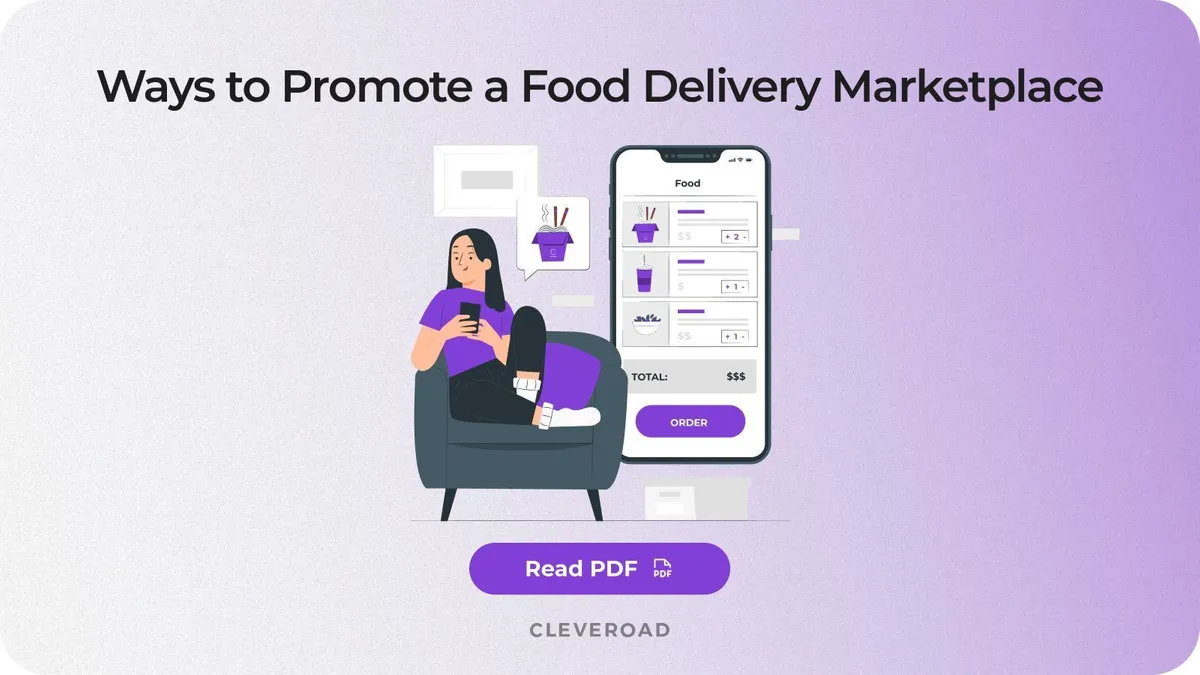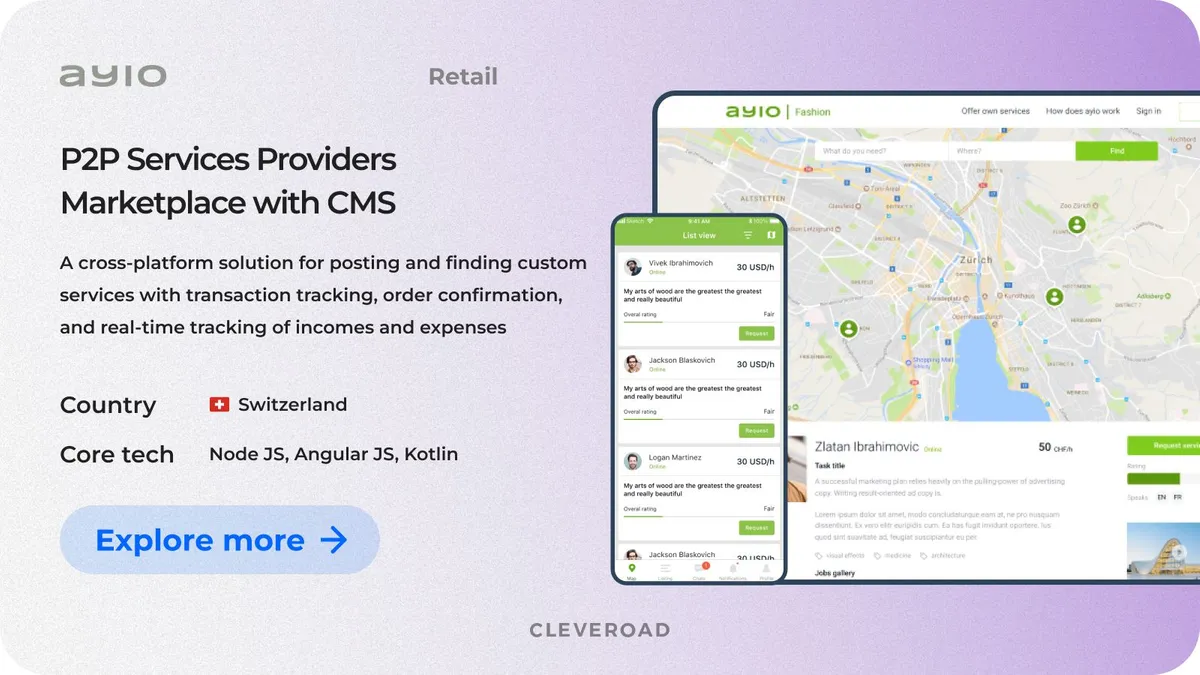How to Make an App Like Uber Eats: Features, Cost and Tools
Updated 27 May 2024
13 Min
8164 Views
Recent study finds that Uber Eats was downloaded nearly 11.2 million times by the U.S. users in 2023. Great time for online food startups to flourish, isn’t it? And that’s exactly what Uber Eats, Foodpanda, GrubHub, and similar platforms do.
But it's not easy to build an app like Uber Eats. The mobile app development takes time, finances, and you won’t fit all the features in a single app. You need one application for users, another for couriers, and an admin panel for restaurants. Each having its own development complexities.
In our article, we’re discussing all the ropes of build a food delivery app like Uber Eats and promoting it.
Food Marketplace Models
There are two food startup models that take a big share of the current market. Let’s take a more detailed look at both options to help you better understand how to create an app like Uber Eats.
Order-only platform
Order-only apps act as an aggregator showing nearby eateries to app users. They connect customers with a wide network of food venues. The system gathers information about restaurants, and users get access to menus, look through restaurants’ rates and reviews, and so on.
This model helps restaurants to expand their market—while customers simply look for a good place to order food from. These platforms do not offer delivery services, though (restaurants have to use their own couriers), they gain profit by charging up to 15% commission to restaurants.
Here’s how it works:
- Users choose food and place an order.
- The payment is authorized within the system.
- A restaurant receives the order and starts preparations.
- The food is handed to the restaurant's courier.
- The courier brings food to the customer, payment is deducted.
The biggest challenge for such startups is building a wide network of nearby food venues. App owners should look for all possible partners, including small eateries.
Examples of order-only apps:
All these platforms are well-designed and have different filters (by dish, location, price) to help users find the best eatery. Still, they remain limited in options and income sources.
Order & Delivery Platform
Order & delivery model differs from restaurant aggregators as it provides full logistics support. These services are a great asset for startups, small restaurants, and other minor venues. New entrants often don’t have enough resources to establish their own delivery, so they turn to companies that provide such services for a fee.
With a order & delivery platforms, restaurants no longer need to worry about delivery management—personnel, vehicles, fare cost.
Order and delivery services work in the following way:
- Users place an order, payment gets authorized.
- Eatery receives the order and starts food preparation.
- The platform arranges delivery by providing their own couriers.
- When the order is ready, the eatery notifies a courier.
- The courier picks the food up and completes the delivery.
- When the customer confirms the delivery, payment is deducted.
These platforms charge restaurants up to 30% of total order price. In addition, customers also pay a delivery fee (fixed or depending on the distance).
Examples of order & delivery platforms:
How to start a business like Uber? Learn how to choose the revenue model and pricing in our detailed article
Uber Eats Monetization Models
This article is about Uber Eats like app development, and during this journey, it’s impossible to avoid discussing Uber Eats' approaches to monetizing their activity. Here are 6 Uber Eats main monetization strategies:
Delivery fees
Uber Eats charges their clients with a delivery fee for each order placed through the platform. The fee are usually not fixed, and it vary based on factors such as the distance between the order pick-up point and the customer, the demand for online food app services at the time of the order, and also egional pricing policies. Gathering delivery feed is a straightforward way for the company to earn money directly from its users.
Service fees
Apart from delivery fees, Uber Eats also placed a service fee on each order. In essence, this fee is a percentage of the order total and is used to cover the cost of transaction accomplishment and customer support.
Commission from restaurants
Uber Eats takes a commission from the restaurants for every order made through the platform. Usually the commission ranges from 15% to 30% of the order value, depending on the agreement between Uber Eats and the particular restaurant. This is a significant source of revenue, that also allows Uber Eats to onboard as many restaurants as possible.
Subscription services
If you think that the subscription-based monetization model is commonly utilized only among streaming platforms, the Uber Eats approach serves as a complete refutation. It offers a subscription service known as Uber Eats Pass or Eats Pass. Subscribers pay a monthly fee to receive particular benefits like free delivery on orders over a certain price and reduced service fees.
Features to Add to an App Like Uber Eats
If you want to create an app like Uber Eats, it’s important to establish that the whole digitized food delivery business consists of 3 main solutions, including:
- Solution for users
- Solution for couriers
- Admin panel for restaurants
Let’s outline 3 types of food delivery apps:
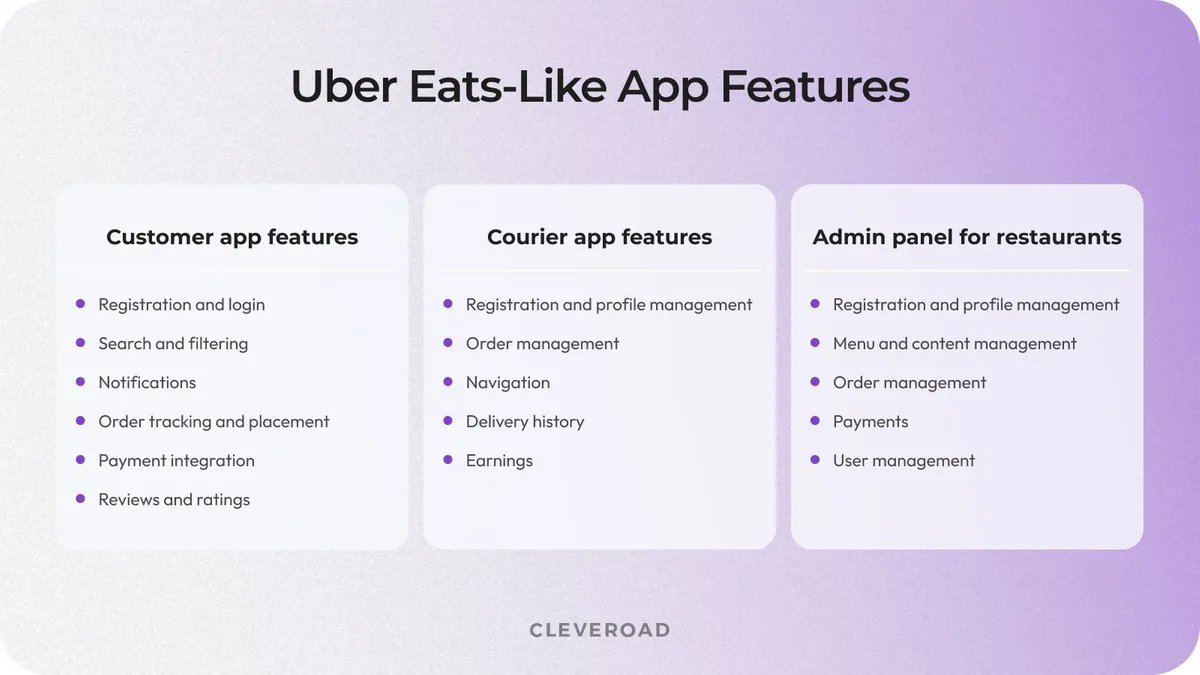
Feature set to develop a food delivery app like Uber Eats
Customer food delivery app features
The customer app is aimed to allow users to seamlessly examine the restaurants and their food offers, and place their orders and delivery requests. Here are the main features of the customer-side interface for uber eats app development:
- Registration and login. Here users start their journey, by by signing-up with the convinient authentication method like phone number, email, social media account, etc.
- Restaurant search and filtering. It’s a convenient tool for a user to sort restaurants by cuisine, ratings, location, and delivery time
- Notifications. Users receive concise messages about their order status or discounts
- Order tracking and placement. Users can place orders and track delivery in real time
- Payment integrations. A user can accomplish payments through the most convenient method like credit/debit card, Apple Pay, Google Pay, or just the option to pay in cash or card to courier
- Reviews and ratings. With this tools users can read previously placed reviews and ratings and leave their own ones too.
| Feature | Estimated time (iOS) | Estimated time (Andriod) | Estimated time (Web) |
Registration and login | 79 h | 80 h | 50 h |
Restaurant search and filtering | 82 h | 87 h | 70 h |
Notifications | 10 h | 10 h | 14 h |
Order placement | 19 h | 19 h | 20 h |
Tracking | 30 h | 30 h | 20 h |
Payment integrations | 40 h | 40 h | 40 h |
Reviews and rating | 10 h | 10 h | 10 h |
Courier food delivery app features
Courier-side interface helps drivers enter essential information like photo, phone number, access order details including order destination address, order size, and also accept suitable orders.
Besides, along with your IT vendor, you can consider including a chat capability to enable delivery men to interact with clients and restaurant managers directly.
Let’s take a closer look at key features of your food delivery app for couriers.
- Registration and profile management. This should contain a simple and intuitive sign-up process with verification and secure login
- Order management. Helps delivery personnel to view order details, update order status, etc.
- Navigation. This tool includes an integrated map with efficient route planning and navigation
- Delivery history. A chronological list of all completed orders with order numbers, dates, and times.
- Earnings. An efficient tool for earnings tracking and payout management
| Feature | Estimated time (iOS) | Estimated time (Andriod) | Estimated time (Web) |
Registration and profile management | 20 h | 20 h | 15 h |
Navigation | 30 h | 30 h | 10 h |
Delivery history | 12 h | 12 h | 15 h |
Eanings | 18 h | 18 h | 18 h |
Order management | 46 h | 48 h | 30 h |
Admin panel for restaurants features
The administrative app for restaurants helps them integrate their services with the digitized food delivery process, as well as accept and manage order details. Besides, restaurants can place their menu, dish descriptions, and photos, as well as allow customers to choose the nearest restaurant depending on their geolocation.
Here are the most important features of the restaurant side interface you should include during Uber Eats-like app development:
- Registration and profile management. Enable restaurants go through easy sign-up process, as well as upgrade restaurant details like contact information, working hours, etc.
- Menu and content management. Let restaurants add, edit, or remove menu items, along with prices, images, and descriptions
- Order management. This tool helps restaurants to view and manage incoming orders
- Payments. Provide restaurants with financial reports, data analytics, and the ability to manage transactions and payouts
- User management. With this feature, restaurants can create and manage accounts for the restaurant staff, as well as set different access levels for workers
| Feature | Estimated time (Web) |
Registration and profile management | 30 h |
Menu and content management | 140 h |
Order management | 60 h |
Payments | 80 h |
User management | 75 h |
You can decide whether you’ll implement basic or advanced functionality. To avoid budget overruns and timeline collapses, it’s recommended to start with Minimum Viable Product (MVP) food delivery app development. This is a version of your app with basic functionality that helps you test the software concept and functionality in real-world conditions without overlaying an app with excessive functionality in advance.
How to Make an App Like Uber Eats: 6 Steps to Follow
While finding an answer to the question of how to make an app like Uber Eats, the primary step is to make the creation process well-structured. Below, we’ve prepared a list of 6 steps to assist you in finding the most efficient way to create your own food delivery app similar to Uber Eats:
Step 1. Define your business goals
Next, you’ll need to define your business goals. This may be accomplished by defining the following aspects:
- The pain points your food delivery app will resolve
- You target audience
- Budget for the food delivery app creation
- Key Performance Indicators (KPIs)
Besides, you as a product owner, along with your development team, will have to determine the approximate scope of the project and allocate a budget according to your general needs and capabilities.
Step 2. Conduct market research and planning
To develop an online food delivery app like Uber Eats, it’s recommended to start by conducting detailed market research and planning the integration of a new digital solution into your current business landscape. This involves analyzing the current food delivery market, identifying the main competitors, understanding your customer needs, and defining your target audience. Keep up with your business model and set clear objectives to guide the project.
An experienced software development vendor can provide you with comprehensive assistance during all this stages.
Step 3. Find a reliable IT vendor
Once you’re done with setting your goals, find a reliable IT vendor with comprehensive experience in providing mobile app development services. Access their portfolio, check client reviews on platforms like Clutch, and ensure they have the necessary technical expertise in technologies relevant to your demands to ensure the chosen partner can qualitatively help you create a food delivery app.
Note: Cleveroad has a wide experience of delivering software solutions for different niches, including on-demand applications like Uber Eats. We focus on building solutions to fit your business domain and budget considerations. Feel free to check our portfolio and assess our expertise by yourself.
Step 4. Define delivery app feature set
Then, your IT vendor will help you define the delivery app's feature set. This will involve identifying core functionality, such as order placement, GPS tracking, and menu management, to ensure a smooth and simple experience for customers, couriers, and restaurant admins. Plan what advanced feature you’d like to implement and also outline the MVP to launch your Uber Eats-like app quickly and iterate based on user feedback.
Step 5. Develop intuitive UI/UX
How to build an app like Uber Eats and make it intuitive for users? Primarily, focus on conciseness and simplicity and avoid overloading your food delivery app interface with excessive details, buttons, or bulky fonts. Intuitive UI/UX is always fixated on a user-centric approach. Your UI/UX designer will assist you in creating wireframes and prototypes to visualize the app’s flow and design and conduct user testing to gather feedback and refine the design.
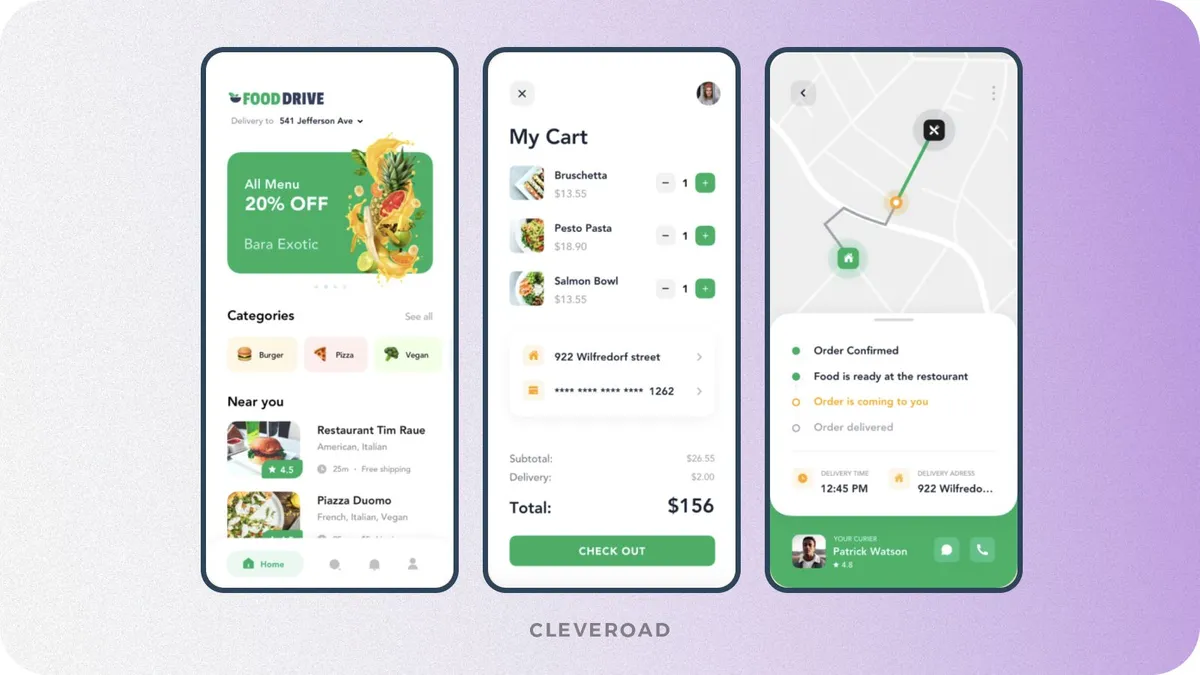
Food delivery app UI/UX design by Cleveroad. Source: Dribbble
Step 6. Support and promote your delivery app like Uber Eats
Remember to support your Uber Eats-like app by launching it and continuously monitoring its performance with the help of your third-party vendor. They will update your food delivery app regularly to fix bugs, improve existing functionality, add new features if requested, and enhance security.
Besides, feel free to to check our cheat sheet that disclose marketing aspects of Uber Eats-like app creation. There you'll learn how to define your target audience, how to identify their pain points and resolve them, how to define reliable buisness partner and much more.
Tech Side and Development Team for Uber Eats-like App Development
Let's dive into more technical aspects of a food marketplace development. Based on our experience in foodtech, we've singled out an approximate tech stack.
Web stack
- Backend: Node.js., Express 4, MySQL, Redis
- Frontend: React, Redux
Mobile stack
- iOS: Swift
- Android: Kotlin
Frameworks and libraries:
- Mailing service: Amazon SES
- SMS service: Twilio
- Synchronization: Socket.io
- Push notifications: FCM
- Social media integration: Facebook SDK
- Maps: Google Maps
- Navigation: Google Directions
- Addresses: Google Places
- Payment provision: Braintree
This list of technologies is not final and provided FYI. It may differ from app to app according to business objectives, features, and platforms.
Development team:
- Project Manager
- Business Analyst
- Solution Architect
- UI/UX designer
- Android engineer (2)
- iOS engineer (2)
- Front-end developer
- Back-end developer
- QA engineer
- DevOps engineer
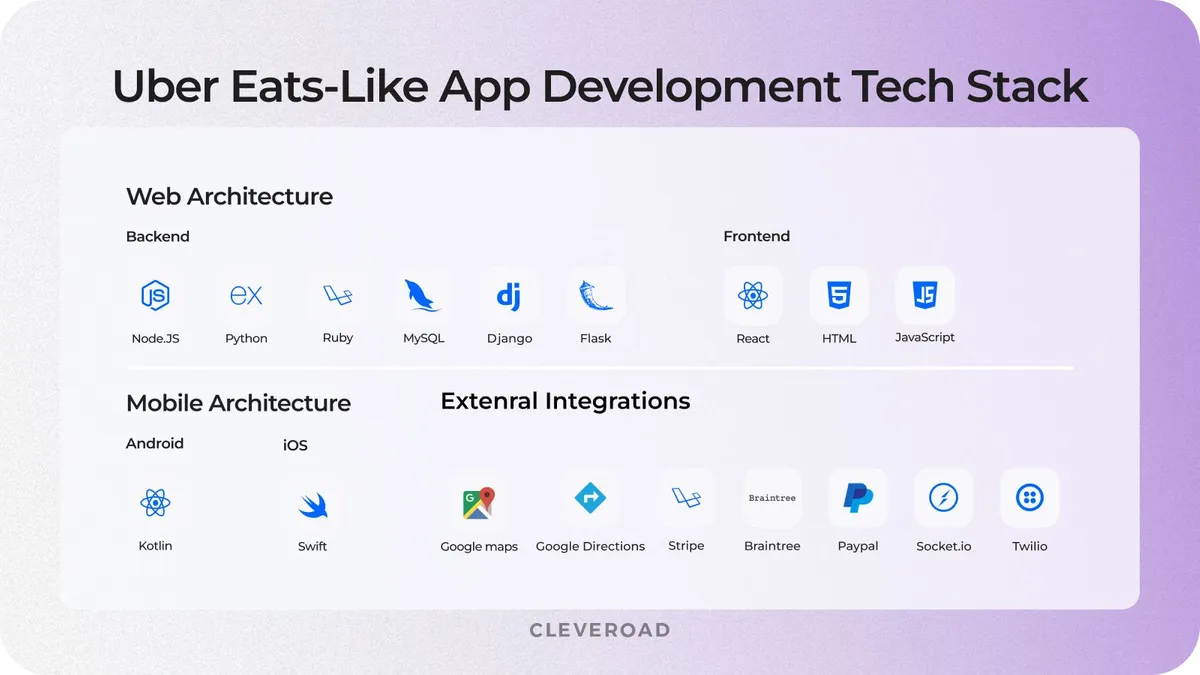
Tech stack to develop an app like Uber. Eats
Why Outstaff Uber Eats-Like App Development
Developing an Uber Eats-like app through an outstaffing model implies hiring dedicated software development team from an external vendor to work as part of your extended team. The outstaffing model may be confused with outsourcing, but the main difference is that during outstaffing, you retain complete control over project management and development flow. At the same time, outsourcing implies handling all project creation processes to a third-party vendor.
However, benefits remain the same. This includes prevalent cost-effectiveness, selection of experts from a wider talent pool, access to solid risk mitigation approaches, scalability and flexibility compared to hiring full-time team, and much more.
How Much Does It Cost to Build an App Like Uber Eats?
Finally, it’s time to define the approximate food delivery Uber-like app development cost. Our Business Analysts have estimated the development cost of the following apps based on the average hourly rate in Central and Eastern Europe – 50$/h:
- Customer App
- Courier App
- Admin Panel for restaurants
- Super Admin Panel for owner
- Frameworks and libraries integration
| Service type | Development time | Estimated cost |
Customer app | 297 h | 44,550$ |
Courier app | 118 h | 17,700$ |
Admin panel for restaurants | 310 h | 15,500$ |
Super Admin Panel for owner | 206 h | 10,300$ |
Frameworks and libraries integration | 55 h | 8,200$ |
Please note that food marketplaces often include a fully-fletched web application which was not added to the estimation.
As you see, you’ll need at least $96,000 to make an app like Uber Eats with only basic functionality. This number is extracted by adding development and non-development time and multiplying the time by the software specialists' hourly rates.
Apart from this, the pricing may also vary depending on your development team's location. For example, if you decide to outsource software development to a vendor from North America, the price tag will be significantly higher than in Central and Eastern Europe, which may not always reflect the same high quality.
Here are the average software development hourly rates in the most popular outsourcing regions:
- North America: $100-$200/h
- Central and Eastern Europe: $30-$60/h
- Australia: $80-$150
- Western Europe: $60-$120
Our Expertise in Food Delivery App Development
Cleveroad is an outsourcing software development company with headquarters in Estonia, Central and Eastern Europe. Throughout 12+ years, our software development experts have provided businesses of various scales with mobile, web, and cross-platform custom software development services, IT consulting, legacy software modernization, and more.
Our competence includes software solutions delivery for various domains, including Retail, Logistics, Marketplaces, Healthcare, Education, etc.
Finally, we’d like to introduce an on-demand platform we’ve developed — Ayio. While working on this project, we added several features similar to what Uber-like apps have. Namely:
- Quick switching between customer and vendor roles
- A sophisticated search system with categories
- Integrated Stripe to collect and send payments fast
- A real-time tracking of incomes and expenses with estimations for a specific service
Build an app like Uber Eats with us
Contact us to make an intuitive and competitive food delivery app leveraging our dedicated software development specialists' expertise
To make an Uber Eats-like app, keep up with the following steps:
- Step 1. Define your business goals
- Step 2. Conduct market research and planning
- Step 3. Find a reliable IT vendor
- Step 4. Define delivery app feature set
- Step 5. Develop intuitive UI/UX
- Step 6. Support your Uber Eats-like app
- Step #1. Define your target audience.
- Step #2. Create a business plan.
- Step #3. Find developers and UI/UX designers. There are two popular options—in-house or outsource software programmers.
- Step #4. Develop must-have features of the Uber Eats-like app.
- Step #5. Release the app on the App Store and Google Play.
It depends on the country where you hire developers, features you want to include, whether you want custom UI/UX design, and lots of other factors.
The development of an Uber Eats-like platform (iOS+Android apps+Backend+Admin Panels) in Estonia, Eastern Europe, costs around $95,600 ($50/rate).
Must-have features of Uber Eats app for customers:
- Registration and profile management
- Search field
- Order placement
- Payment
- Order tracking
- Notifications
- Rating & reviews
Additional features:
- Bookmarks
- Order history
- Estimated delivery time
- Discount system
- Social networks
Must-have features of Uber Eats app for couriers:
- Registration and profile setup
- Order management
- Status updates
- Delivery history
- Earnings screen
Admin panel for restaurants:
- Registration and profile management
- Content management
- Order management
- Payments
There are four ways Uber Eats earns money:
- Charges a delivery fee from users (rates depend on the distance)
- Charges 30% fee from restaurants
- Charges a so-called ‘fee for busy areas’
- Offers paid in-app advertising

Evgeniy Altynpara is a CTO and member of the Forbes Councils’ community of tech professionals. He is an expert in software development and technological entrepreneurship and has 10+years of experience in digital transformation consulting in Healthcare, FinTech, Supply Chain and Logistics
Give us your impressions about this article
Give us your impressions about this article
